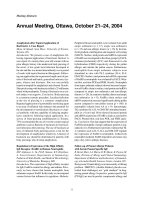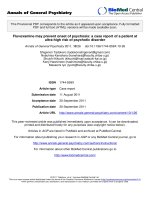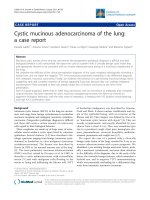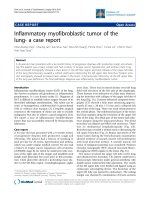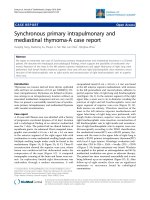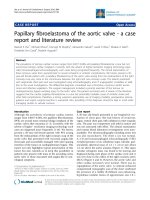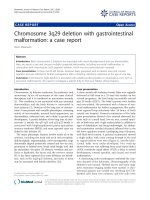Báo cáo y học: " Triple intussusception involving heterotopic pancreatic tissue: a case report" pdf
Bạn đang xem bản rút gọn của tài liệu. Xem và tải ngay bản đầy đủ của tài liệu tại đây (395.32 KB, 4 trang )
BioMed Central
Open Access
Page 1 of 4
(page number not for citation purposes)
Journal of Medical Case Reports
Case report
Triple intussusception involving heterotopic pancreatic tissue: a
case report
N Sautot-Vial* and H Steyaert
Address: Lenval Fundation for Children, Department of Pediatric Surgery, Avenue de la Californie, 06200 Nice, France
Email: N Sautot-Vial* - ; H Steyaert -
* Corresponding author
Abstract
Introduction: Intussusception involving heterotopic pancreatic tissue is a rare condition where a
portion of the bowel telescopes into an adjacent segment with intraluminal pancreatic tissue as the
lead point. Cases of heterotopic pancreas are most often described in the upper intestinal tract,
particularly the stomach.
Case presentation: We present the case of a five-month-old boy of Caucasian ethnicity suffering
acute abdominal pain and vomiting with an abdominal mass in the upper right quadrant. Work-up
including ultrasound scan confirmed the intussusception. Repeated attempts at radiological
reduction and two laparoscopic procedures were performed within 24 hours, which eventually led
to the diagnosis of a triple intussusception.
Conclusion: To our knowledge, such a case of triple intussusception involving isolated
heterotopic pancreatic tissue is previously unreported.
Introduction
Intussusception is a not uncommon surgical problem
occurring in children. It is defined as a prolapse of part of
the intestine into the lumen of an immediately adjoining
part. In infants, this entity accounts for the most common
cause of intestinal obstruction. It is often idiopathic and
rarely caused by an abnormal process. A triple intussus-
ception occurs when three separate segments telescope
into the same distal segment.
The management of intussusception under laparoscopy is
developing and offers effective results in many patients. In
our patient, however, the diagnosis could not be made
after the first laparoscopy and, as a matter of fact, only one
intussuscepted loop was reduced at first. Eventually, radi-
ological clues led us to diagnose an unusual form of intus-
susception.
Case presentation
A five-month-old boy of Caucasian ethnicity presented at
our pediatric emergency unit. He had suffered acute par-
oxysmal abdominal pain and bilious vomiting for nine
hours. His general condition and vital signs were normal.
During physical examination, an abdominal mass was
noted in the upper right quadrant - there was no blood in
stools in the rectum. Biological examinations did not
yield significant results, but an ultrasound scan revealed a
target sign in the form of an opaque mass under the liver.
An air enema reduction was performed and identified a
Published: 18 November 2009
Journal of Medical Case Reports 2009, 3:134 doi:10.1186/1752-1947-3-134
Received: 19 September 2009
Accepted: 18 November 2009
This article is available from: />© 2009 Sautot-Vial and Steyaert; licensee BioMed Central Ltd.
This is an Open Access article distributed under the terms of the Creative Commons Attribution License ( />),
which permits unrestricted use, distribution, and reproduction in any medium, provided the original work is properly cited.
Journal of Medical Case Reports 2009, 3:134 />Page 2 of 4
(page number not for citation purposes)
loop in the transverse colon that was refluxing under air
pressure. This procedure did not result in a complete
reduction of the assumed intussusception even after two
attempts under midazolam infusion. An ileocolic intus-
susception of 2 cm was diagnosed during the laparoscopic
exploration and a reduction was carried out by applying
gentle traction. The adjacent small intestine and the
ascending colon had a normal color and the child had
normal peristalsis. The procedure was finished on these
reassuring signs. During the night, the boy suffered
repeated episodes of vomiting and had blood in his
stools. An ultrasound scan performed in the morning
revealed an intussusception, a swelling of the distal small
intestine and the presence of a mass in the pouch of Doug-
las. It was difficult to determine with confidence whether
the intussusception was ileocolic or ileoileal.
A second laparoscopic procedure determined that the
intussusception was not ileocolic. The cecum was in its
usual location, and there was no inflammation of the
appendix. The small intestine was examined more closely
and an intussusception was found, located 40 cm above
the ileocolic junction. A reduction attempt failed even
with the help of a third forceps. A right hemitransverse
abdominal incision was performed but the reduction
attempt failed. Palpating the ascending colon revealed a
diffuse induration with no signs of wall necrosis. The
small intestine appeared normal. A transverse enterotomy
was performed 5 cm before the ileocolic junction. An
intussusception of a bowel segment was identified but it
could not be reduced. After full exploration, a tumor of
less than 15 mm was identified at the top of the first intus-
susception. 40 cm of ileum was resected and an end-to-
end anastomosis (A-B) was performed. The postoperative
course was uneventful.
Histologic examination indicated the presence of 12 mm
of heterotopic pancreatic tissue (Figure 1). The first intus-
susception was 60 cm away from the ileocolic junction
with ileal heterotopic pancreatic tissue as the lead point.
The second intussusception, which formed an additional
loop on the first one, was located 40 cm away from the ile-
ocolic junction. The third intussusception completed the
telescoping in the ascending colon (Figure 2).
Discussion
This case is interesting for several reasons: (1) The triple
telescoping of adjacent gut segments; (2) the isolated ileal
heterotopic pancreatic tissue as lead point; (3) the failure
of two laparoscopic procedures to reduce the intussuscep-
tion.
We shall discuss each of these aspects in turn.
Triple intussusception of the small bowel
In the literature, only five cases of triple intussusception
have been reported both in pediatric and adult series
[1,2]. They originated from benign tumors (such as a
lipoma or hemangioma), hyperplasic polyp, parasitosis
or heterotopic tissue (as in our patient). None of them
were idiopathic. On the other hand, simple intussuscep-
tion is more often idiopathic in the pediatric population.
Other causes of simple intussusception are Meckel's diver-
ticulum, angioma, digestive duplication and lymphoma.
Conversely, in the adult population, the main etiology is
almost exclusively of tumoral origin. The main clinical
symptom remains acute abdominal pain. In all of these
cases, the diagnosis of triple intussusception was made
during surgery. In our patient, radiological investigations
revealed only one abnormal loop in the ascending colon
after an attempt at air enema reduction. In certain cases of
triple intussusception, reports say that there were no
abnormal signs at this stage.
Heterotopic pancreatic tissue in the ileum
There are no cases of a triple intussusception due to iso-
lated heterotopic pancreatic tissue described in the litera-
ture. Nevertheless, intussusceptions and double
intussusceptions involving heterotopic pancreatic tissue
have been reported [3-8]. The pancreas is derived from
several evaginations of the wall of the duodenum. The
dorsal diverticulum forms the body and tail, and the ven-
tral portion the head of the pancreas. If an evagination is
located on the bowel wall, it can form ectopic tissue any-
where in the gut [3].
Histologic view of the ileal lead pointFigure 1
Histologic view of the ileal lead point.
Journal of Medical Case Reports 2009, 3:134 />Page 3 of 4
(page number not for citation purposes)
Cases of heterotopic pancreatic tissue have been observed
most frequently in the stomach, duodenum and jejunum.
Ileal lesions are rare. The presence of heterotopic pancre-
atic tissue occurs in one per 500 cases of upper abdominal
operations and up to 5% of autopsy cases. In the ileum,
heterotopic pancreatic tissue is commonly associated with
a Meckel's diverticulum. Symptoms can be associated
with complications such as intestinal obstruction, bleed-
ing from a mucosal ulcer, intussusception and obstruction
of the common bile duct [4]. Half of the cases of hetero-
topic pancreatic tissue are asymptomatic and diagnosed
incidentally.
Laparoscopic surgery and intussusceptions
In recent years, numerous reports have described the suc-
cessful management of intussusception in pediatric and
adult series [9,10] and various publications relate success-
ful laparoscopic reductions in 50 to 65% of cases. A study
by Kia et al. [9] underlined the effectiveness of such an
approach in children under 3 years and advised against its
use in older patients where resection is needed more
often. Exploration of the entire small bowel is easily feasi-
ble by open surgery and remains a conventional method
of intussusception treatment for the majority of surgeons.
On the other hand, laparoscopy is a procedure that risks
silent injuries such as tears or gut perforation. In our
patient, incomplete examination led to the need for re-
operation after a laparoscopic attempt at reduction which
missed the remaining double intussusception. Thanks to
a second laparoscopic procedure performed a few hours
later, we were able to diagnose this exceptional case of tri-
ple intussusception.
Final study of the triple intussusception after two laparoscopic procedures and one conversionFigure 2
Final study of the triple intussusception after two laparoscopic procedures and one conversion.
Publish with BioMed Central and every
scientist can read your work free of charge
"BioMed Central will be the most significant development for
disseminating the results of biomedical research in our lifetime."
Sir Paul Nurse, Cancer Research UK
Your research papers will be:
available free of charge to the entire biomedical community
peer reviewed and published immediately upon acceptance
cited in PubMed and archived on PubMed Central
yours — you keep the copyright
Submit your manuscript here:
/>BioMedcentral
Journal of Medical Case Reports 2009, 3:134 />Page 4 of 4
(page number not for citation purposes)
The literature rarely mentions triple intussusception, but
references to double intussusception are not so uncom-
mon.
Conclusion
To our knowledge, this is the first case report of a patient
with a triple intussusception involving isolated hetero-
topic pancreatic tissue.
Consent
Written informed consent was obtained from the patient's
parents for publication of this case report and any accom-
panying images. A copy of the written consent is available
for review by the Editor-in-Chief of this journal.
Competing interests
The authors declare that they have no competing interests.
Authors' contributions
NSV was involved in conception, design, and preparation
of the manuscript. HS acquired and analysed the data, and
drafted the manuscript.
Acknowledgements
JS Valla is thanked for giving final approval of the version to be published.
References
1. Habib E, Elhadad A: Triple jejuno-jejunal intussusception dis-
covered and treated with laparoscopy. J Chir (Paris) 1997,
134:133-136.
2. Bulucea D: Triple intestinal invagination as the cause of
chronic painful abdomen in a child. Rev Pediatr Obstet Ginecol
Pediatr 1983, 32:281-284.
3. Kazez A, Ozel SK, Kocakoc E, Kiris A: Double intussusception in
a child: the triple-circle sign. J Ultrasound Med 2004,
23:1659-1661.
4. Chandra N, Campbell S, Gibson M, Reece-Smith H, Mee A: Intussus-
ception caused by a heterotopic pancreas. Case report and
literature review. JOP 2004, 5:476-479.
5. Scholz S, Loff S, Wirth H: Double ileoileal intussusception
caused by a giant polypoid mass of heterotopic pancreas in a
child. Eur J Pediatr 2000, 159:861-862.
6. Hamada Y, Yonekura Y, Tanano A, Takada K, Kato Y, Sato M, Sakaida
N, Okamura A, Hioki K: Isolated heterotopic pancreas causing
intussusception. Eur J Pediatr Surg 2000, 10:197-200.
7. Pang LC: Pancreatic heterotopia: a reappraisal and clinico-
pathologic analysis of 32 cases. South Med J 1988, 81:1264-1275.
8. Kitchin AP: Intussusception due to ectopic pancreatic tissue.
Lancet 1952, 2:989-990.
9. Kia KF, Mony VK, Drongowski RA, Golladay ES, Geiger JD, Hirschl
RB, Coran AG, Teitelbaum DH: Laparoscopic vs open surgical
approach for intussusception requiring operative interven-
tion. J Pediatr Surg 2005, 40:281-284.
10. Poddoubnyi IV, Dronov AF, Blinnikov OI, Smirnov AN, Darenkov IA,
Dedov KA: Laparoscopy in the treatment of intussusception
in children. J Pediatr Surg 1998, 33:1194-1197.
